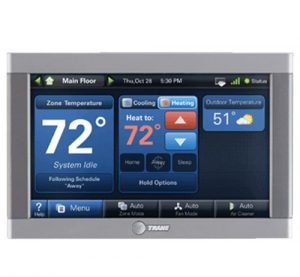Just as a well-insulated vacuum flask keeps your coffee hot on a cold day, the insulation in your home serves to keep your living spaces at the ideal temperature, regardless of the weather outside.
It’s an unsung hero that directly influences your home’s energy efficiency, comfort, and utility costs.
This article explores how insulation impacts the efficiency of your Heating, Ventilation, and Air Conditioning (HVAC) system and why it’s crucial to pay attention to it.
Looking for reliable insulation inspections? Contact BelRed Energy Solutions today to set an appointment!
What is Insulation?
Insulation, in the context of building and construction, is a barrier material designed to resist and minimize the flow of heat. Its fundamental principle is based on the fact that heat naturally flows from warmer to cooler spaces.
In summer, when outdoor temperatures rise, heat tries to seep into the cooler interiors of a home. In contrast, during winter, the heat within your home strives to escape to the colder outdoors.
This is where insulation steps in, acting as a shield that reduces this heat flow, helping to maintain a stable, comfortable indoor environment throughout the year.
What is R-Value?
The effectiveness of insulation is measured by its R-value, which indicates its resistance to heat flow. The higher the R-value, the greater the insulating effectiveness. The required R-value for a home depends on the local climate, the type of heating and cooling system installed, and the part of the house being insulated.
Types of Insulation
The world of insulation offers a variety of choices, each with its unique properties, advantages, and applications. Here’s an expanded look at the three main types:
Batt Insulation
Often referred to as blanket insulation, batt insulation is one of the most common types used in homes, primarily because it’s easy to install and relatively inexpensive. It comes in rolls or pre-cut panels that fit snugly between the studs in your walls or the joists of your ceilings and floors.
The primary materials used in batt insulation are fiberglass and rock wool. Fiberglass batts are lightweight and easy to handle, while rock wool batts (made from molten rock or blast furnace slag) have superior fire resistance and soundproofing qualities.
Blown-In Insulation
Blown-in, or loose-fill, insulation is another popular choice, especially for hard-to-reach areas, irregularly shaped areas, and obstructions.
This type of insulation is installed using a blowing machine that propels streams of small particles of insulating material (fiberglass, cellulose, or mineral wool) into the cavities or attics.
Cellulose blown-in insulation, made from recycled paper products treated for fire and mold resistance, is an eco-friendly option.
Spray Foam Insulation
Spray foam insulation is a two-component mixture that combines at the tip of a gun, and forms an expanding foam when sprayed into wall cavities, floors, or roofs. This type of insulation comes in two varieties: open-cell and closed-cell.
Open-cell spray foam is lighter and cheaper but offers a lower R-value. Closed-cell spray foam, on the other hand, provides a higher R-value and can also add structural strength to the walls.
Spray foam insulation is known for its excellent air-sealing properties, ability to fill in gaps and cracks, and high insulating value, making it a premium choice for homeowners.
If you need help finding the best insulation for your home, BelRed Energy Solutions is here for you. Contact us at (855) 345-6161 to schedule an appointment or book one online now!
How Does Insulation Affect Your HVAC’s Performance?
Insulation is a critical factor in determining your HVAC system’s performance and efficiency.
A well-insulated home reduces the heat transfer between the indoor and outdoor environments, which in turn impacts your HVAC system in the following ways:
- Energy consumption: When a home is under-insulated, the HVAC system must work harder and longer to compensate for the heat loss in winter and heat gain in summer. This increased workload results in higher energy consumption, driving up your utility costs.
- Equipment lifespan: An overworked HVAC system due to poor insulation experiences more wear and tear, which can lead to a shortened lifespan for your heating and cooling equipment. Replacing an HVAC system can be expensive, so ensuring proper insulation can help protect your investment in the long run.
- Indoor comfort: A well-insulated home helps maintain a consistent indoor temperature, reducing the need for constant adjustments to your thermostat. This improved temperature stability enhances overall comfort and reduces stress on your HVAC system.
- Air quality: Proper insulation, coupled with a well-sealed building envelope, helps reduce the infiltration of outdoor pollutants, allergens, and moisture, thereby improving indoor air quality. This benefits not only your HVAC system but also the health and well-being of your household.
Signs of Air Leaks in Your Home Insulation
Air leaks can compromise the effectiveness of your insulation and negatively impact your HVAC system’s efficiency. Keep an eye out for the following signs that may indicate air leaks:
- Condensation or frost on windows, suggesting excessive indoor humidity
- Unexplained drafts, cold spots, or fluctuating temperatures in different parts of your home
- Unusual odors or increased allergic reactions, indicating compromised indoor air quality
- Discoloration, stains, or mold on walls or ceilings, pointing to moisture issues
- Higher than average energy bills, suggesting increased HVAC system workload
- Frozen pipes or ice dams during winter, implying insufficient insulation
- Presence of pests, attracted by warmth or moisture in your home
- Excessive noise transfer between rooms, indicating poor sound insulation
Addressing these issues can help improve your home’s insulation, leading to a more energy-efficient and comfortable living environment while reducing stress on your HVAC system.
Experience higher comfort and ease with BelRed’s AC repair, installation, and maintenance services. Contact us today for more details!
How to Inspect Your Home’s Insulation
Regular inspection of your home’s insulation is crucial in maintaining an energy-efficient home. Not only does it help identify potential issues that could compromise your HVAC system’s performance, but it also ensures a comfortable living environment.
Here’s a step-by-step guide on how to inspect your home’s insulation:
Attic Insulation
Your attic is a significant source of heat transfer, making it an essential area for insulation. To inspect attic insulation:
- Visual Inspection: Start by visually examining the insulation. It should cover all areas of the attic uniformly, leaving no gaps, voids, or compressed spots. Look out for signs of moisture or mold, as these could indicate a leak in the roof.
- Depth Check: Using a ruler, measure the depth of the insulation. Check that this depth meets or exceeds the recommended levels for your climate zone. Remember, insulation’s effectiveness is measured by its R-value, and a higher R-value means better insulating power.
- Material Check: Identify the type of insulation used (fiberglass, cellulose, spray foam) as different materials have different R-values per inch.
Wall Insulation
Inspecting wall insulation can be more challenging, given its location behind drywall or other wall coverings. Here’s how to go about it:
- Infrared Camera: One method is to use an infrared camera, which can show temperature differences on the surface of your walls. Cooler areas may indicate missing or inadequate insulation.
- Electrical Outlet Check: Another simple method is to remove the cover plate from an electrical outlet and probe into the wall with a thin tool, such as a plastic straw, to check for insulation. Be sure to turn off the power before doing this.
- Professional Energy Audit: For a comprehensive understanding of your home’s insulation status and overall energy efficiency, consider hiring a professional to conduct an energy audit. This service typically includes a thermographic inspection using advanced tools like infrared cameras.
Basement/Crawl Space Insulation
Basements and crawl spaces can be significant sources of cold drafts and moisture infiltration. To inspect these areas:
- Visual Inspection: Look for any signs of moisture or water damage, which can reduce the effectiveness of insulation and potentially lead to mold growth.
- Rim Joists: Pay special attention to the rim joists – these are the areas where your house’s floor framing meets the foundation. Rim joists are often overlooked during insulation, but they can be a significant source of heat loss if not properly insulated.
- Wall Insulation: If your basement or crawlspace has wall insulation, check it for any signs of damage or gaps. Like in the attic, the insulation should be continuous and uniform.
Importance of Proper Insulation for Your HVAC System
Insulation isn’t just about keeping your home cozy during winter and cool during summer—it’s an integral component of an efficient and effective HVAC system. Here’s why:
Energy Efficiency
Proper insulation reduces the strain on your HVAC system by minimizing heat transfer between your home and the outdoors. This means your system doesn’t have to work as hard to maintain a comfortable indoor temperature, which can significantly reduce energy consumption.
Cost Savings
By improving energy efficiency, insulation can also lower your utility bills. Think about it: less heat transfer means your HVAC system runs less frequently, and that can add up to substantial savings over time.
Comfort and Consistency
High-quality insulation contributes to a more consistent indoor temperature, eliminating cold drafts in winter and hot spots in summer. This consistency enhances overall comfort, making your home a more enjoyable place to live.
Longevity of Your HVAC System
An HVAC system that doesn’t have to work as hard tends to last longer. By reducing strain on your system, proper insulation can extend its lifespan, saving you the expense and inconvenience of premature replacement.
Invest in Comfort and Efficiency with BelRed Energy Solutions!
At BelRed Energy Solutions, we offer more than just high-quality insulation services—we’re your one-stop-shop for all your HVAC needs, including AC Repair, Installation, and Maintenance Services.
Our team of seasoned professionals is dedicated to improving your home’s comfort and reducing your energy bills. From assessing your current insulation to upgrading it for optimal performance, we’re with you every step of the way.
Don’t settle for an overworked HVAC system and rising energy costs. Reach out to BelRed Energy Solutions today.







